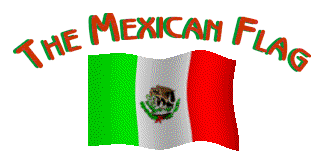

The Mexican flag embodies the rich history of Mexico by evolving from at least three different traditions: the indigenous, the colonial and hispanic religious heritage and the liberal force that advocated the creation of independent sovereign states.
The flag consists of three bands of colors green, white in the middle and red, with the white part containing the symbol of the eagle and the snake.
The indigenous heritage: The cactus, the eagle and the snake
The symbol of the eagle standing on a cactus plant and devouring a snake comes from the times of the Aztecs.The Aztec people were guided by their god Huitzilopochtli to seek a place where an eagle landed on a prickly-pear cactus, devouring a snake. After hundreds of years of wandering they found the sign on a small swampy island in Lake Texcoco. Their new home they named Tenochtitlan ("Place of the Prickly Pear Cactus"). In A.D. 1325 they built a city on the site of the island in the lake; which is now Mexico City.
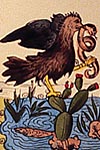
Mythical sign for the foundation site of Tenochtitlan
The eagle and the snake are symbols that pervade the mythology of the Aztecs and ancient Mexico in general. The Atl-Tlachinolli, represents an eagle with the symbol of sacred war in its beak.
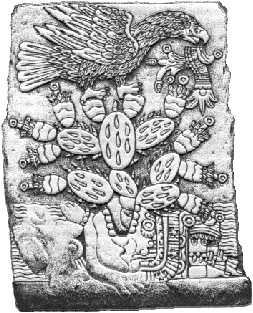
Atl-Tlachinolli, the symbol of sacred war
Other codeces represent the eagle in opposition with the snake as in the Borgia Codex:
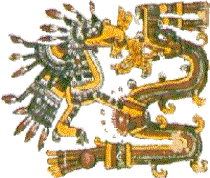
The eagle in opposition to the snake
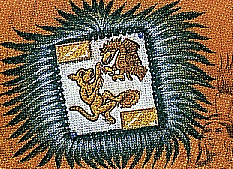
Several banners were used by the Aztecs. Each squad had a distinctive banner representing each calpulli. Each commander had its own special banner. The Huitznahuatl banner used the same colors as the present flag.
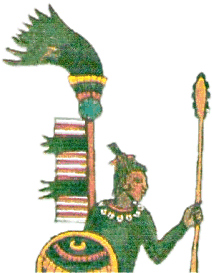
Huitznahuatl Flag
As part of the protocol of war once the cihuacoatls banner was lost, the battle was considered lots, a fact that was used by the Spanish conquistadores to their advantage.
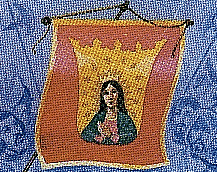
Once in Mexican lands Cortés adopted a flag with the image of the Virgin Mary.
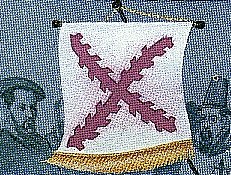
This flag was used during the early XVI century, it has a St Andrews Cross at the center and at the end of its arms the coat of arms of Mexico City. It was placed at the balcony of the National Palace during official ceremonies.
By this time the symbol of the eagle on the cactus was being used in many places including flags just like the one used by the forces sent to Florida in 1559-1560 which included Mexica soldiers.
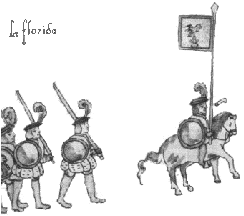
Expeditionary Force to the Florida, 1559
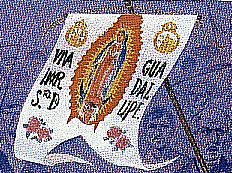
Once the fight for independence was initiated by Hidalgo, and passing by Atotonilco el Grande (present-day Guanajuato), adopted a painting of the Virgin of Guadalupe from the chapel there as a banner for its forces. After learning this, the Royalists forces reciprocated by adopting a banner with an image of the Virgin of the Remedies from the sanctuary of the same name in Mexico City and given her the rank of Marshall.
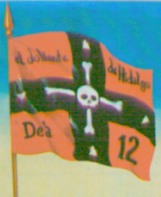
"Doliente de Hidalgo"
This flag was used by the rebels after Hidalgo was executed.
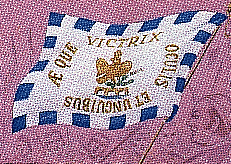
In 1812, Gen. Don José María Morelos y Pavón created a flag for his revolutionary forces. This flag displays for the first time an eagle on a cactus plant, although the eagle is in a frontal position and wearing an imperial crown; the cactus resting on top of an aqueduct and surrounded by a legend in Latin. This flag was present with the Morelos forces in the battle of Valladolid (now Morelia).
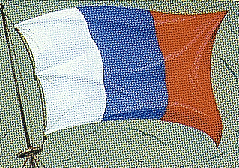
The revolutionary forces fighting for the independence of Mexico also had another flag, which was used by military ships that guarded the coasts of the Gulf between Mexico and the U.S. It has three colors: white, blue and red.
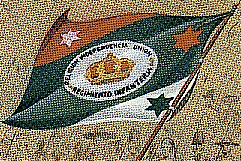
During the government of Iturbide, the Puebla provisional Infantry Regiment was bestowed with a flag displaying a white oval at the center encircling a crown with a legend at the top that reads: "Religión, Independencia, Unión" and in the lower part: "Regimiento de Infantería."
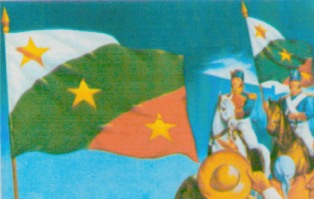
The "El Plan de Iguala" (September 24, 1821) promulgated by Iturbide ended the war of independence and was represented by a flag, so called the flag of three warranties, and whose manufacture was carried out by José Magdaleno Ocampo.
This flag has three diagonal bands of different colors: white, symbolizing purity of the Catholic religion; green, symbolizing the Independence and red representing the Spanish adherents to the indpendence. This flag paraded on September 27, 1821 marking the consummation of the Independence war.
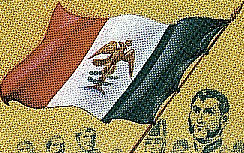
On November 2,1821, Don Agustín de Iturbide as President of the Interim Junta of government integrated by 38 others; decreed that the National flag should be composed of vertical bands with green, white, and red; with a crowned eagoe at the center resting on the mythical cactus. This flag was used during the Empire period of Iturbide, starting July 21, 1822.
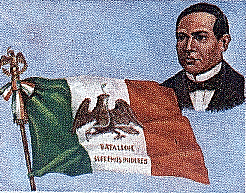
When President Benito Juárez established his Government in San Luis Potosí, the Battalion "Supremos Poderes" stationed in the state of México changed its name to Primer Batallón de Infantería (First Battalion of Infantry). It took part in battle against the French at Morelia, in several other battles and in the siege of Querétaro, when the triumph of the Republic was imminent.
After the fall of Iturbide in 1823, Congress decreed the removal of the crown from the eagle but adding a semi-circle of laurel and encino leaves surrounding the eagle.
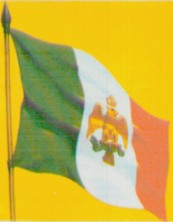
Emperor Maximilian Flag
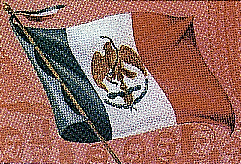
This battalion of the army was organized in Linares, N.L., and participated in many battles, such as the asault on Matamoros, Tamaulipas, the defense of Querétaro, and later supporting the forces of General Porfirio Díaz.
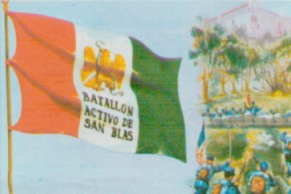
Among many heroic feats, the Batallion participated in the defense of Monterrey and several other places during the US invasion in 1846, and finally in the defense of the Castle of Chapultepec in 1847 along with the noted Niños Heroes, and where his leader, General Santiago F. Xicotencatl, was seriously injured and wrapped in their flag and thereby avoiding the capture of the flag.
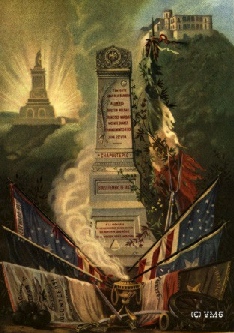
Homage to the Niños Heroes

Flag from the Porfirio Diaz era
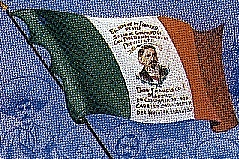
Don Venustiano Carranza issued a drecree in 1916 that mandated that the eagle in the official seal be displayed on its side rather than frontally as it was being done since the end of the previous century.
As part of the Allied forces during World War II, Mexico sent troops to the Phillippines. Escuadrón 201, Squad 201, was the first expeditionary force to be sent abroad. Its flag was solemnly dedicated February 23, 1945.
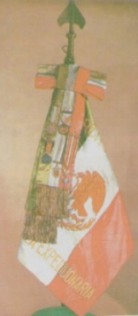
WWII Expeditionary Forces Flag
The official seal underwent several changes in this century.
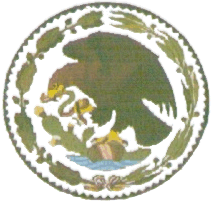
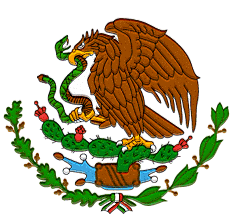
By decree of September 17, 1968, the current official seal of arms came into existence with a few changes from that decreed by Dn. Venustiano Carranza in 1916. The official Flag Day is February 24 as decreed in 1940.
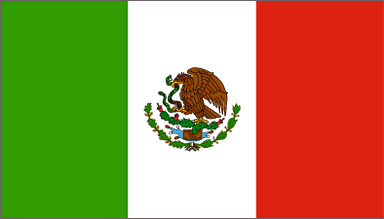
The flag is displayed proudly by Mexicans in virtually every place.
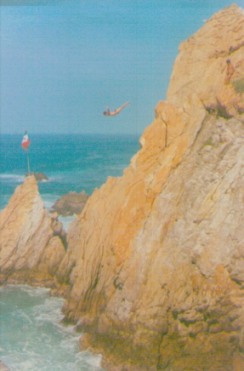
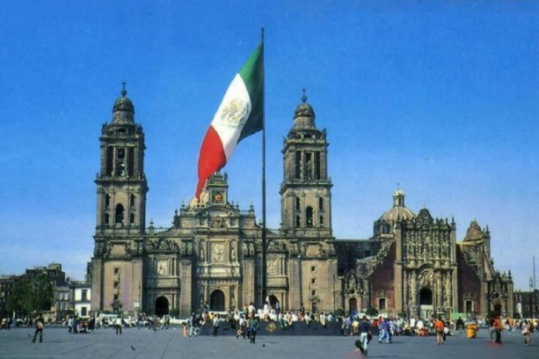
Copyright © 1997-2000 VMG